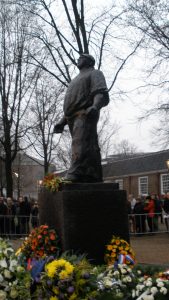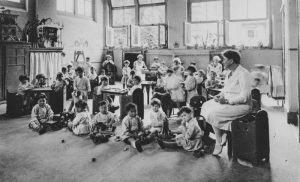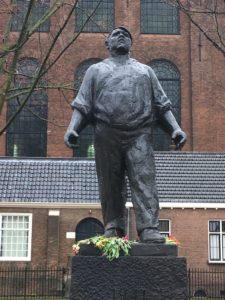On this date every year, I tell two stories: the February Strike in Amsterdam which is still little known outside the Netherlands, and how my life changed when I attended the 60th commemoration of that Strike in 2001. As with Passover and Christmas, the stories don’t change much, but every year they have different insights to offer. New facts and memories always appear if I pause and look for them. This year is the eightieth anniversary, and given the pandemic it will have only a virtual celebration and broadcast, so it’s even more important to write and remember.
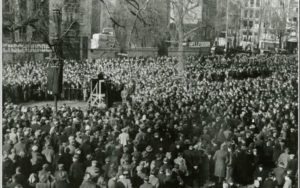
The February 25 Strike in Amsterdam, 1941
On the historical side, I try to learn something unfamiliar about the Strike every year, as well as reminding myself and everybody else of why and how it happened. When the word spread that 425 Jewish men had been rounded up in the Jonas Daniel Meijerplein, the communists and trade unions reacted first. Without the internet to help them, they immediately organized a meeting at the Noorderkerk in the Jordaan, the workers’ quarter.
Overnight, they produced a mimeographed sheet: “Strike! Strike! Strike!” to protest the roundup. Was it the dockworkers who struck first on February 25, or the tram workers? It doesn’t really matter. My new fact for this year is that workers on bicycles pedaled through the city went and knocked on doors to bring people into the streets. They were wildly successful, with 300,000 people participating. Those who have read An Address in Amsterdam may recall that my heroine Rachel attends the Strike, and it’s her first link to the resistance. That scene was re-created from historical accounts and photos, so I feel as if I was there myself.
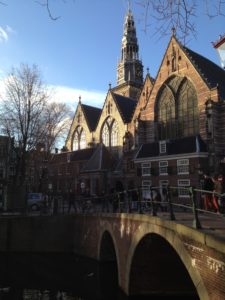
The Noorderkerk, where the Strike was organized
People decided to strike in a context that would dishearten almost anyone. The Nazis had been in power since the prior May 1940. The Aryan attestation had been inflicted on all government employees, which meant many had been fired for being considered Jewish – people like the musicians in the Concertgebouw orchestra, professors at the universities, civil servants at all levels. The press was under the German thumb, so people were already depending on underground papers which would multiply later. The economic hardship of war had begun, and people needed their jobs more than ever. They lived in a society where being law-abiding was a cardinal virtue. And yet they decided to strike. Not because their uncles and brothers had been rounded up, but because their Jewish fellow citizens and comrades were under attack.
Many Jewish people were largely assimilated into the middle class, and somewhat in the working class. One theory about why the Dutch protested the first roundup when others did not is the personal connections among workers, since in many industries Jews and Gentiles worked side by side. Another factor is that the Netherlands was a far more open and tolerant society than many around it – a secular, commercially based country with a high regard for human rights. And yet another is that many Dutch hated the Germans and the Occupation, and the Strike expressed that.
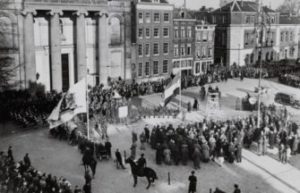
Source: Dutch National Archive
The measure of their actions is not effectiveness in a practical sense. They didn’t stop the Germans; in fact, the reprisals were severe, beginning with bloodshed on the streets and ending with executions of 18 of the organizers. What they created, however, is this: a beacon that is still shining on us, enjoining us to speak up for what we know is right. That moment of solidarity still illumines our lives and changes our reality. What is the challenge to us, when we read about the example of people who saw a moral outrage committed, and immediately organized to make a widespread and public protest? Today, when we see a great wrong being committed, we know it is our duty to act.
My first moment of understanding all that was exactly twenty years ago. Come back with me. It is a frigid day, grey like many Amsterdam winter days, with a pervasive chill. My partner Joanna and I stand as close together as we can, held back by a fence. We are in the Jonas Daniel Meijerplein, named for the Netherlands’ first Jewish lawyer. The immense 17th century Portuguese Synagogue looms over us, its windows providing the only illumination within. Behind us are the four small Ashkenazi Synagogues, skillfully merged into today’s Jewish Historical Museum. I’d never heard of the February Strike until I visited there the week before. “Does anything special happen on the 25th?” I’d asked.
The guard pointed out the glass doors. “Yes, right by the statue of The Dockworker over there. He’s the symbolic figure of the Strike. Come at 5:00.”

The Dockworker, by resister Mari Andriessen
Joanna and I did, as a gesture of respect for the strikers who made a futile but courageous and beautiful effort. We arrived at 5:02, but the event was already in process. We’d expected hours of speeches and a modest crowd, but instead the square is absolutely crammed. Within ten minutes silence falls, and here we are. A few people at a time are allowed to step forward (from an orderly line, of course) and lay flowers at the feet of the beefy Dockworker. Although the crowd is mixed in age and otherwise, the first people permitted to approach are the oldest, their white hair shining against their dark coats, some utterly upright and others bent or needing a wheelchair.
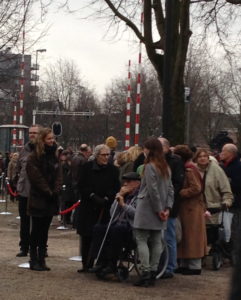
Someone who remembers
The woman behind us whispers that these are the living strikers, and their families and friends. Their faces are somber. No one looks proud or pleased with themselves; the ghosts of the Jewish people who were rounded up are too close for that. The Strike isn’t mere history that happened before I was born in 1948. These people, their very bodies, had been there, and now we are in the same place and time, connected. They had been there. And “there” is here, where the roundup had actually happened, where the strikers had surged past, hundreds of thousands of them. The story knocks me on the head like a bat. These people are all here to remember, and their story has become mine. Mine to reckon with, be tormented by, and find some way to tell. It isn’t just something in a book; the people who had been rounded up in this square had almost all been murdered, and so had the strike organizers.
Only the flowers make it bearable at all.
Almost everyone except us has brought them: everything from small batches of forced forsythia cut at home to immense formal displays. The procession to the Dockworker moves very slowly: first the strikers, then synagogues, Jewish organizations, labor unions and churches, then countries, and finally individuals. Each one bends over to lay their flowers among the others, choosing their spot, then straightening up and pausing to remember, perhaps to pray. They move along, and the handful of people follows. The whole event takes on a meditative pace. If we weren’t shivering, time would hardly seem to pass at all.

Grandmothers hold hands with little ones and probably tell the story that must never be forgotten, a few people of color watch quietly until it’s their turn, and oblivious toddlers ride on their father’s tall shoulders. The sun is going down somewhere behind the clouds, and the darkness thickens. Still the people keep coming to the feet of the Dockworker, still pile flowers by the flowers that were already heaped, arranging them so nothing is hidden.
At last, at 6:30, it is our turn. We waited until the very end, as outsiders with nothing to offer but ourselves.
We kneel. We are close enough to see the flowers now. A note in spidery handwriting is attached to a bunch of white snowdrops, held together with aluminum foil. Hebrew letters embossed in gold on broad ribbons flow around an arrangement of cascading scarlet tulips. The printed words from the “people and government of Sweden” bedeck a sumptuous wreath of red roses and white lilies. The fragrance is euphoric, mingling spring and summer on that dark, cold day. It gives the dead back to us, makes us feel their courage and the terrible loss. It gives us the stories to tell as long as we live.

